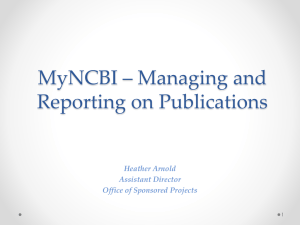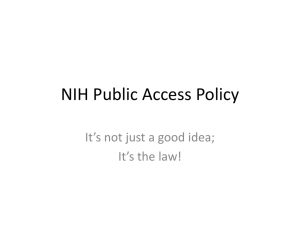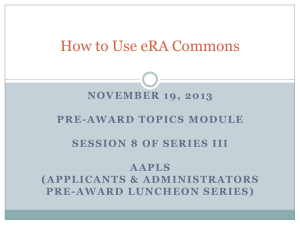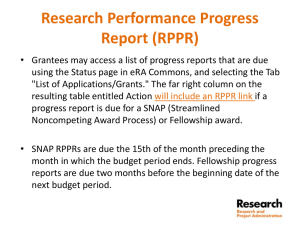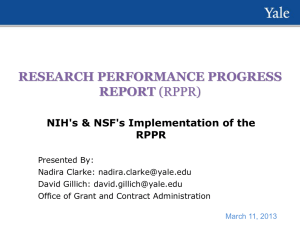nih-public-access
advertisement
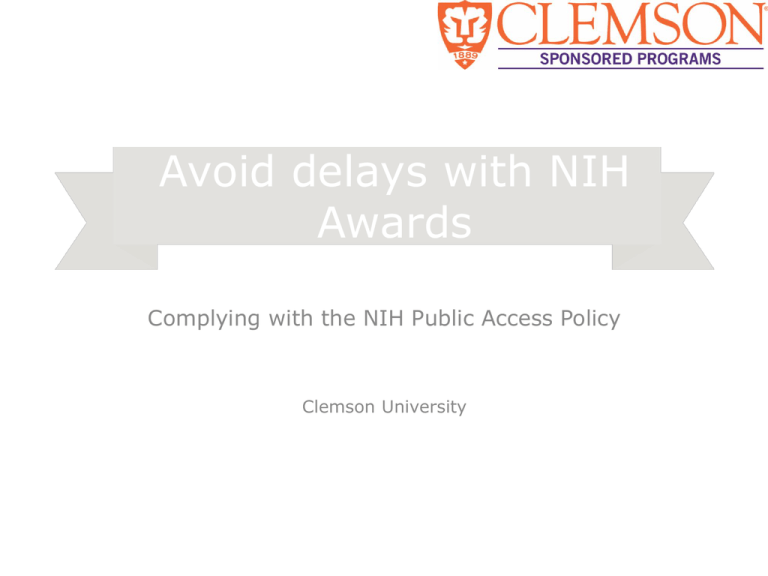
Avoid delays with NIH Awards Complying with the NIH Public Access Policy Clemson University Presenters and Panel Members Mandy McCaslan and Diana Thrasher Office of Sponsored Programs Diana Finkle Clemson University Library Casandra Gibson Office of the Vice President for Research Karen Lantgios Grants and Contracts Administration 5 Points to Cover Today 1. The NIH Public Access Policy 2. How to Ensure Publications Become Compliant 3. Overview of The National Center for Biotechnology Information Portal (MyNCBI ) 4. Clemson’s Action Plan for Non-compliant Publications 5. Review the NIH Research Performance Progress Report (RPPR) The NIH Public Access Policy The NIH Public Access Policy Is Mandatory • The Policy implements Division G, Title II, Section 218 of PL 110161 (Consolidated Appropriations Act, 2008) which states: The Director of the National Institutes of Health shall require that all investigators funded by the NIH submit or have submitted for them to the National Library of Medicine’s PubMed Central an electronic version of their final, peer-reviewed manuscripts upon acceptance for publication, to be made publicly available no later than 12 months after the official date of publication: Provided, That the NIH shall implement the public access policy in a manner consistent with copyright law. • NIH Guide Notice NOT-OD-08-033 http://grants.nih.gov/grants/guide/notice-files/NOT-OD-08033.html • NIH Guide Notice NOT-OD-09-071 announces the policy is permanent, per the Consolidated Appropriations Act, 2009 http://grants.nih.gov/grants/guide/notice-files/NOT-OD-09071.html Pub Med vs. Pub Med Central Free resources developed by the U. S. National Library of Medicine • Database of biomedical journal citations, abstracts, and • Links to some full text articles from PMC and publisher websites. • Unique identifier: PMID followed by a series of numbers. • Digital archive of full-text, peer-reviewed journal papers. • Unique identifier: PMCID followed by a series of numbers. NIH Public Access Policy is Mandatory • What to submit? Final, peer-reviewed manuscripts that are accepted for publication, or published. • When to submit? Upon acceptance for publication • When to make public? No later than 12 months after the official date of publication • Where to make public? The National Library of Medicine’s PubMed Central NIH Enhanced Public Access Policy Effective July 1, 2013 on ALL NIH awards. Other Information • Happening in tandem with the mandate of the Research Performance Progress Reports (RPPR) • RPPR replaces forms PHS 2590 for eSNAP and 416-9 for Fellowships • Upcoming RPPR due dates • May 1, 2013, for Fellowships • May 15, 2013 for SNAP awards • Projects must be in compliance in order to avoid delay in funding NIH Enhanced Public Access Policy Next, we will overview how to be compliant in three steps: 1. Link publications to your NIH grant: • • Manuscript files through the NIH Manuscript System (NIHMS) Full text and final articles through PubMed Central 2. In My Bibliography of MyNCBI 3. In the RPPR – live feed of publications from MyNCBI, can associate the grant to the publication, which will feed back to MyNCBI (a two-way feed) How do you make sure publications become compliant? How Awardees Comply 1. Address Copyright – Institutions and investigators are responsible for ensuring full compliance with the Public Access Policy (e.g., that any publishing or copyright agreements are consistent with submitting to PMC). – Before an author signs a publication agreement or similar copyright transfer agreement, make sure that the agreement allows the final peer-reviewed manuscript to be submitted to NIH in accordance with the Public Access Policy. We encourage authors to consider – What submission method will be used? – What version of the paper will be made available on PMC? – Who will submit the paper? – When will it be submitted? – Who will approve the submission? – When can the paper be made public on PMC? How Awardees Comply 2. Deposit Paper Upon Acceptance for Publication – Method A: Publish in a journal that deposits all NIHfunded final published articles in PMC without author involvement. – Method B: Make arrangements to have a publisher deposit a specific final published article in PMC. – Method C: Deposit the final peer-reviewed manuscript in PMC yourself via the NIHMS. – Method D: Complete the submission process for a final peer-reviewed manuscript that the publisher has deposited via the NIHMS. 3. Cite Article – Include the PMC number (PMCID) for applicable papers in applications, proposals and reports, as described at http://publicaccess.nih.gov/citation_methods.htm Overview of Submission Methods How the library can help • Use this interactive tool to find out what steps you need to take: – http://www.surveymonkey.com/s/findpmcid • Get more information about the process from the library website: - http://libguides.clemson.edu/nih • Contact a librarian if you have questions about searching the databases: http://www.clemson.edu/library/reference/askALibrarian.html What is My NCBI? What is My NCBI? My NCBI is a bibliography management tool integrated with PubMed. My Bibliography is part of My NCBI with Public Access tracking and reporting features. Key features for our discussion: Can be linked to eRA Commons account Build bibliography Commons linked users can associate publications with NIH grants Tracks NIH Public Access compliance The only way to enter publications into RPPR Other time savers: Delegation, options to share and publish bibliographies, automate searches, etc. Log in to My NCBI Things to remember • Need to get PMCID#s for ALL papers to which the NIH Public Access Policy applies. • Policy applies to papers “accepted for publication” (not published) on or after April 7, 2008 Action Plan for Non-compliant Publications Review the Public Access Compliance status of each citation ? - Public Access Compliance “No funding has been associated with this citation” Address any non-compliant citations Review RPPR Research Performance Progress Report (RPPR) http://grants.nih.gov/grants/rppr/ Mandatory Use of the RPPR for SNAP and Fellowship Awards Electronic format only Replaces forms PHS 2590 for eSNAP, and 416-9 for Fellowships Budget start dates on or after July 1, 2013 RPPR due dates May 1, 2013, for Fellowships May 15, 2013 for SNAP awards RPPRs Available now What about non-SNAP awards? • RPPRs will be implemented for non-SNAP late 2013/early 2014 • Includes T32s and other complex mechanisms • The progress reports for these grants require budgets, unlike the SNAP awards and fellowships • NIH trying to incorporate the SF424 budget forms into the electronic RPPR, but they are not there yet! • Continue to submit the progress reports for these special grant mechanisms as you have been • Competing progress reports will require a PAPER PDF printout from My NCBI to demonstrate that publications are compliant with the Public Access Policy Summary of New Information Requested • Competitive revisions/administrative supplements Specific location to report aims & accomplishments (B.3) • Foreign Collaborations (sub-awards): Individual affiliation with foreign organization (D.1) Dollar amount of award spent in foreign country (E.4) Information about foreign components (G.9) • Participants – role on project New role-High School Student; slight rewording of other roles (D.1) • Level of Effort Prior approval request for reduction of >25% for PD/PI or other individual designated on NoA (D.2.a) • Estimated unobligated balance Provide estimated amount and description of how funds will be spent (G.10) Points to Remember • Special characters not permitted in text boxes • Disregard items marked “Not Applicable” • Round person months to nearest whole number • All uploads must be PDF files Sample RPPR http://grants.nih.gov/grants/rppr/rppr _screen_shots.pdf RPPR and E-Notification • Trigger: When a grantee submits a RPPR to NIH that associates one or more publications with the award for which the public access compliance status is “Noncompliant”. • Recipients: to the PD/PI, with a cc to the OSP, GMS, IC mailbox, and PO. • Response: The grantee may respond to the eNotification via email or through the Progress Report Additional Materials (PRAM) link. What is PRAM? Progress Report Additional Materials (PRAM) An option in the eRA to provide additional materials for a progress report. Currently, PRAM is ONLY being used to address non-compliant publications. PRAM will eventually be required. PRAM also available in Status Section of eRA Commons Questions? Contact Us Office of Sponsored Programs cuosp@clemson.edu Library dfinkle@clemson.edu and rook@clemson.edu Compliance casandg@clemson.edu Grants and Contracts Administration klntgs@clemson.edu Resources • • • • • • • • • • • • • Clemson University Interactive Guide to Finding a PMCID Number Guidance on complying with the NIH Policy – Clemson University Library NIH Public Access Policy Recent podcasts regarding the enhanced Public Access Policy Public Access Training Public Access FAQs RPPR Training Resources Log in to My NCBI NIH Research Performance Progress Report (RPPR) NIH Manuscript Submission System FAQs NIHMS System Submission Tutorials For Publishers –FAQs Video – Approving Submission of an Article in PubMed Central
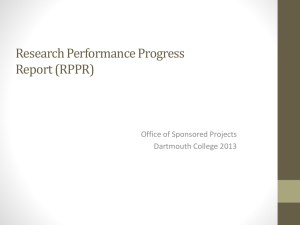
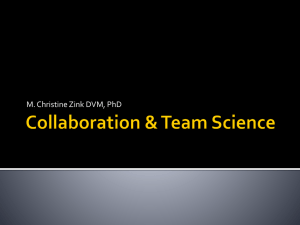
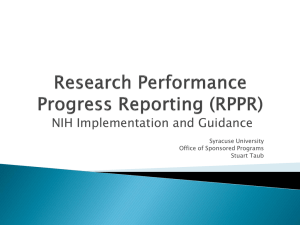
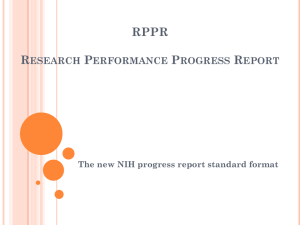
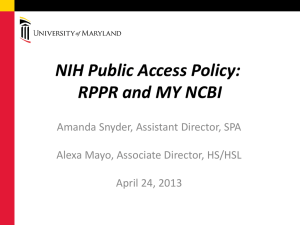
![NIH 101: Part 1 [.ppt]](http://s2.studylib.net/store/data/005398706_1-cbe361c448786ac362a8e75ad39fc05d-300x300.png)
